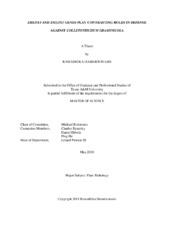| dc.description.abstract | Plant lipoxygenases (LOX) catalyze the production of oxylipins through the oxidization of polyunsaturated fatty acids (PUFA) that are important in plant development and defense. LOXs can be divided into two groups, depending on which carbon in the PUFA carbon chain the enzyme oxidizes. Within the two groups, 13-LOX, which oxidizes the 13th carbon in the chain, is better known than 9-LOX, which oxidizes the 9th carbon. Two maize LOX gene ohnologues, ZmLOX4 and ZmLOX5, are members of the 9-LOX subfamily and share over 94% identity at the amino acid level. Remarkably, despite this extreme homology, these genes have contrasting roles during defense against the causal agent of anthracnose leaf and stalk blight, Colletotrichum graminicola. Functional analyses of knock-out mutants revealed that ZmLOX4 is required for defense against this pathogen, while ZmLOX5 facilitates fungal pathogenicity. The major objectives of this study were: (1) to identify the oxylipin signature produced by the ZmLOX4 and ZmLOX5 pathways and (2) to characterize the downstream molecular and biochemical processes that underlie their contrasting functions against C. graminicola. Among the eleven 9-oxylipins detected during leaf infections, none were found to be specifically produced by the ZmLOX4 or ZmLOX5 pathways, suggesting that as-yet-uncharacterized 9-oxylipins are likely the products of these two homologs. Interestingly, disruption of ZmLOX4 results in lower accumulation of the major defense hormones, salicylic acid (SA) and jasmonic acid-isoleucine (JA-Ile), while mutation of ZmLOX5 results in increased accumulation of SA and JA-Ile. These results suggest that yet-unknown ZmLOX5- produced oxylipins negatively regulate synthesis of both SA and JA, and ZmLOX4-derived oxylipins are positive regulators of SA-dependent defense against C. graminicola. Supporting the hypothesis that lox4 mutants are more susceptible due to lower than normal levels of SA, exogenous SA treatment of lox4 mutant partially rescued the mutant susceptibility phenotype. RNA-sequencing and shot-gun proteomic analysis of infected leaves revealed transcripts and proteins that are differentially expressed in lox4 and lox5 mutants compared to wild-type. The results indicated that in addition to aberrant SA and JA synthesis, the genes and proteins related to production and scavenging of reactive oxygen species (ROS) were also among the most altered outcomes of the mutations. In agreement with these results, lox5 mutant plants produced greater levels of hydrogen peroxide in response to C. graminicola, while lox4 mutants were less responsive in terms of ROS accumulation. Additionally, it was found that conidia germinate at a faster rate on both lox4 and lox5 mutant plants, suggesting that these two genes regulate early stages of infection processes. In conclusion, the data suggest that these two nearly-identical 9- LOXs produce some as-yet unknown oxylipin signals that differentially regulate maize defense response to C. graminicola most notably via regulation of ROS and SA. | en |


